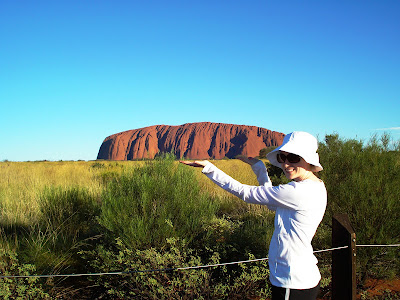We had breakfast as we watched the sun rise, and then it was off to the other main attraction in Uluru National Park- Kata Tjuta. Like Uluru, Kata Tjuta is the aboriginal name for the place that is more commonly known as the Olgas to Westerners.
Since we were there in the summer, there are heat restrictions to the park. No one is allowed to hike in after 11 am, so we had to get there early. There are also public water basins at strategic locations around the park, but it's encouraged not to rely on those, as they can be tapped out on high traffic days. Dehydration and sunstroke is a very real concern in the Outback, and one of the terms of the tour was that everyone carry 3 liters of water on them at all time. We were encouraged to drink constantly- regular sips every few minutes or so.
We had two choices on the hike- a shorter route directly to the main canyon or a longer hike that took a more circuitous route in the other direction and we would meet in the center. Olivia and Laurel opted for route #1, while Greg went on hike #2. Laurel and Olivia are professional, and glamorous, hikers as can be seen below, especially in their matching hats.
Now the two hikes met at the canyon, but Laurel and Olivia's hike came out above it, after a steep climb up the far side. The view was incredible. Check out how burny that sun is!
Greg has learned several things about himself on this trip. First, Laurel is a way better photographer. Secondly, left to his own devices 98% of his pictures will feature trees prominently displayed amongst the landscape.
And here is Greg's approach to the canyon. That's a big hill.
It was tough, but we both made it to the top. The picture oppurtunities made all the hard work totally worth it.
The Aborginal mythology is wide-ranging and literally covers every nook and cranny of the rocks and earth that the individual tribes lived on. Some of it is told to tourists and non-Aboriginals, but it's only the equivalent of what they tell their five year olds as they are beginning to learn their stories. It's very interesting, and we kind of like that idea that some things are too sacred to be shared; they are only for the Aboriginals. Below, this is the "Cat's Face," but we don't know any more about it aside from its name.
A funny thing about Olivia. She has a questionable, relationship with nature. She likes it, but she's not too wild about all those, um, wild creatures out there. Whenever a living thing of any kind appears, Olivia shouts "Animal!" to warn everyone else that something potentially hostile is nearby. "Animal" can mean literally anything- grizzly bear, lizard, ant, you name it. She found this pretty sweet looking lizard, or shall we say, "animal."
Now, you may have thought Uluru was one of a kind (we certainly did), but it's actually the best known of a series of rock slabs spread out across the Outback. It's the largest and one of the few that is still in one piece. During our drive to King's Canyon we stopped at a lookout point to get a few shots of another Uluru-like rock, Atilla. Notice how flat it is compared to Uluru.
Facing the other direction from the lookout point was a dry salt-lake. Pretty incredible. Too bad there aren't any deer in this country; they would love this.
A long drive and a wild camel spotting later (sorry, no pictures) we made it to the King's Canyon campsite. While we stopped for gas, we picked up two eager stowaways.
People are not the only ones who are not big fans of the midday sun, and just want to be in the shade. This peacock decided the campground picnic area was the perfect place for a nice, cool nap. The long table doesn't even ruffle his feathers. He's a very wise peacock.
After a hearty dinner (all that hiking makes you hungry!) we walked over to a nearby ridge to watch the sunset over the valley. A few cows were wandering around, too. Now there is something about the air and sun in Australia that makes every sunset super vibrant and beautiful, but this is hands down the most beautiful one we have seen, probably ever.
Not a bad way to end the day. Not a bad way at all. We camped under the stars in our swags again, and knocked out pretty early, as we were in for another early day tomorrow. Up at 4 AM so we could watch the sunrise over King's Canyon.



































